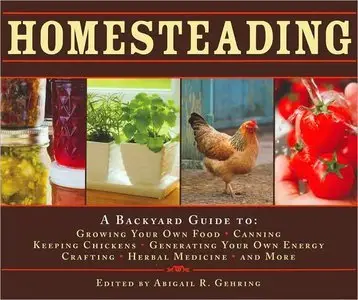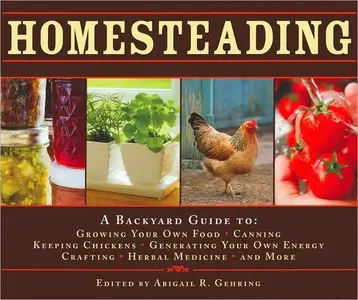Abigail R. Gehring, "Homesteading: A Back to Basics Guide to Growing Your Own Food, Canning, Keeping Chickens, Generating Your Own Energy, Crafting, Herbal Medicine, and More"
Sky….e Pub….ing | 2009-11-01 | ISBN: 1602397473 | 464 pages | epub | 66,9 MB
Sky….e Pub….ing | 2009-11-01 | ISBN: 1602397473 | 464 pages | epub | 66,9 MB
The companion to the bestseller Back to Basics for country, urban, and suburban folks.
Who doesn’t want to shrink their carbon footprint, save money, and eat homegrown food whenever possible? Even readers who are very much on the grid will embrace this large, fully-illustrated guide on the basics of living the good, clean life. It’s written with country lovers in mind—even those who currently live in the city.
Whether you live in the city, the suburbs, or even the wilderness, there is plenty you can do to improve your life from a green perspective. Got sunlight? Start container gardening. With a few plants, fresh tomatoes, which then become canned tomato sauce, are a real option. Reduce electricity use by eating dinner by candlelight (using homemade candles, of course). Learn to use rainwater to augment water supplies. Make your own soap and hand lotion. Consider keeping chickens for the eggs. From what to eat to supporting sustainable restaurants to avoiding dry cleaning, this book offers information on anything a homesteader needs—and more. 1000 color illustrations
From instructions on making your own composting toilet to trimming the toenails on your llamas, this back-the-land guide offers a vast wealth of resources for the eco-minded, twenty-first-century homesteader. The crowded chapters cover growing and harvesting food; keeping livestock (and building structures to house them); incorporating renewable energy technology, such as solar panels, into existing homes; making crafts, household items, and toys; homemade health remedies; and earth-friendly interior design. With so many topics introduced in such a limited space, it’s inevitable that some subjects are treated more superficially than others; for example, a spread on stress management, which includes tips such as “take a walk,” seems out of place in a title filled with so much targeted, useful advice. Best are the practical specifics, and even city dwellers with no interest in taking up beekeeping or basket weaving will enjoy browsing this for recipes, gardening ideas, and, as the introduction states, other accessible ways to “take a few steps closer to a healthier, happier, and more responsible lifestyle.” –Gillian Engberg



